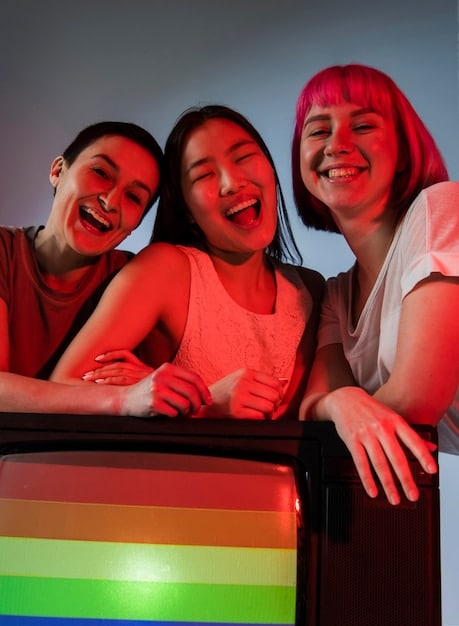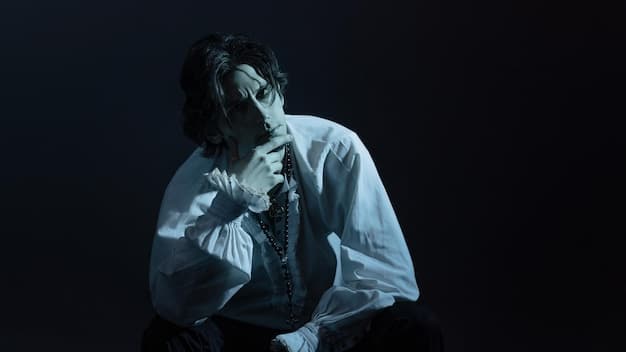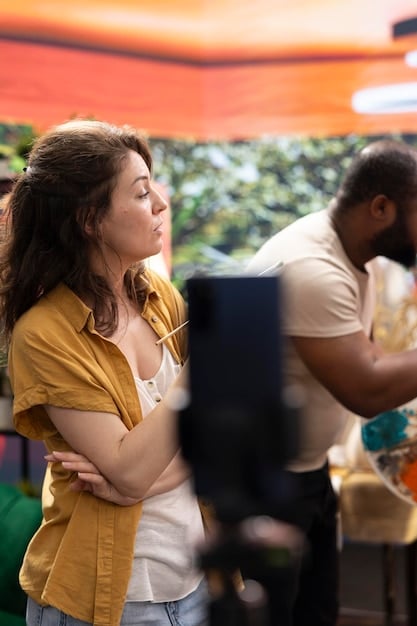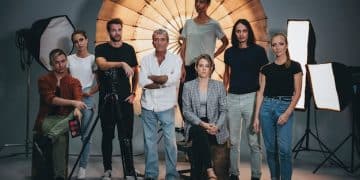LGBTQ+ Representation in Film: A Progress Review

The Representation of LGBTQ+ Characters in Film: A Review of Recent Progress examines the evolution, achievements, and ongoing challenges in portraying LGBTQ+ individuals authentically and inclusively in cinema.
The landscape of cinema is constantly evolving, and with it, the portrayal of diverse communities. The Representation of LGBTQ+ Characters in Film: A Review of Recent Progress takes a look at how far we’ve come and the roads still left to travel.
The Evolution of LGBTQ+ Representation
Early portrayals of LGBTQ+ characters in film were often stereotypical, one-dimensional, or used for comedic relief. More recently, however, there’s been a shift toward more nuanced and authentic representation. But where did it all begin?
From groundbreaking but often problematic depictions to the rise of independent cinema that gave voice to LGBTQ+ stories, the evolution has been complex and varied. Understanding this history is crucial to appreciating the progress made.
Early Stereotypes and Tropes
Early cinema often relied on harmful stereotypes when portraying LGBTQ+ characters. These portrayals frequently presented caricatured versions of gay men and lesbians, reinforcing negative societal perceptions.
Independent Cinema and the Rise of LGBTQ+ Voices
Independent cinema played a vital role in providing platforms for LGBTQ+ filmmakers to share their stories authentically. These films often explored complex themes related to identity, acceptance, and love, paving the way for more mainstream representation.
- Early portrayals often relied on harmful stereotypes.
- Independent cinema provided a platform for authentic LGBTQ+ stories.
- Positive representation can significantly impact societal attitudes.
- Increased visibility helps foster understanding.
From caricature to complexity, the journey of LGBTQ+ representation in film is a testament to the power of storytelling. It underscores the importance of diverse voices in shaping a more inclusive cinematic landscape.
Landmark Films and Performances
Certain films and performances have played pivotal roles in advancing LGBTQ+ representation. These works not only garnered critical acclaim but also sparked important conversations about identity, acceptance, and equality. Let’s delve into some examples.
From “Philadelphia” to “Moonlight,” these films have challenged societal norms and humanized LGBTQ+ experiences. Their impact extends beyond entertainment, influencing culture and shaping perceptions.

“Moonlight” (2016)
“Moonlight” stands out for its sensitive and nuanced portrayal of a young Black man grappling with his sexuality. The film’s poetic storytelling and authentic characters resonated with audiences worldwide.
“Philadelphia” (1993)
Starring Tom Hanks as a gay man fighting for justice after being fired for having AIDS, “Philadelphia” brought LGBTQ+ issues into mainstream consciousness and sparked broader dialogue about discrimination.
Landmark films and performances serve as powerful catalysts for change. By challenging stereotypes, fostering empathy, and promoting understanding, these works contribute to a more inclusive and accepting society.
The Impact of Streaming Services
The rise of streaming services has radically altered the media landscape, offering new opportunities for LGBTQ+ representation in film and television. With greater creative freedom and global reach, streamers are changing the game.
Platforms like Netflix, Amazon Prime Video, and Hulu have greenlit a diverse array of LGBTQ+ content, from documentaries and dramas to comedies and reality shows. This shift has broadened audience access to LGBTQ+ stories.
Increased Visibility and Representation
Streaming services have enabled increased visibility for LGBTQ+ characters and narratives. By investing in diverse voices and stories, these platforms are helping to normalize LGBTQ+ identities and experiences.
Global Reach and Cultural Impact
The global reach of streaming services means that LGBTQ+ stories can now reach audiences in countries where such representation may be limited or even non-existent in traditional media. This fosters greater understanding and acceptance worldwide.
- Streaming services are providing new platforms for LGBTQ+ stories.
- Increased visibility helps normalize LGBTQ+ identities.
- The global reach of streamers promotes understanding and acceptance.
- Original series and films are pushing the boundaries of representation.
Streaming services are democratizing access to LGBTQ+ content, fostering inclusivity, and shaping global perceptions. This new landscape offers both opportunities and challenges for filmmakers and storytellers.
Behind the Camera: LGBTQ+ Filmmakers and Storytellers
Authentic LGBTQ+ representation requires more than just diverse characters on screen; it demands LGBTQ+ voices behind the camera. When LGBTQ+ filmmakers and storytellers control the narrative, the results are often more nuanced and impactful.
From directing and writing to producing and editing, LGBTQ+ individuals are making their mark in every aspect of filmmaking. Their perspectives bring authenticity and depth to the stories being told.

Spotlighting LGBTQ+ Directors
Directors like Xavier Dolan and Dee Rees have gained recognition for their unique storytelling styles and their commitment to portraying LGBTQ+ characters and themes with authenticity and sensitivity.
The Importance of Diverse Writers and Producers
Diverse writers and producers play a crucial role in ensuring that LGBTQ+ characters are complex, multifaceted, and grounded in real-life experiences. Their contributions help avoid harmful stereotypes and promote accurate representation.
When LGBTQ+ individuals have the opportunity to tell their own stories, the result is cinema that is more authentic, compelling, and transformative. Their presence behind the camera is essential for driving progress in representation.
Challenges and Criticisms
While progress has undoubtedly been made, challenges and criticisms persist in the realm of LGBTQ+ representation in film. Issues such as tokenism, stereotyping, and the lack of intersectionality continue to plague the industry.
It’s essential to critically examine how LGBTQ+ characters are portrayed and to push for more authentic and inclusive representation. Addressing these issues requires ongoing dialogue and commitment by the industry.
Tokenism and Superficial Representation
Tokenism occurs when LGBTQ+ characters are included in a film primarily to fulfill diversity quotas rather than to genuinely explore their stories. This can lead to superficial and unsatisfying representation.
The Need for Intersectionality
Intersectionality recognizes that individuals have multiple overlapping identities (e.g., race, gender, sexuality) and that these identities can intersect to create unique experiences of discrimination and oppression. Films need to reflect this complexity.
- Tokenism can lead to superficial representation.
- Intersectionality is crucial for accurate and inclusive storytelling.
- Stereotyping persists, despite progress.
- Authentic representation requires ongoing dialogue and commitment.
By acknowledging these challenges and working towards more inclusive practices, the industry can ensure that LGBTQ+ representation is authentic, meaningful, and empowering.
Looking Forward: The Future of LGBTQ+ Representation
The future of LGBTQ+ representation in film holds both promise and potential pitfalls. As society becomes more accepting and diverse, the demand for authentic and nuanced stories will only increase.
It’s crucial for the industry to continue pushing boundaries, amplifying marginalized voices, and embracing intersectionality. By doing so, film can become a powerful force for change.
Embracing Nuance and Complexity
Future films should move beyond simplistic portrayals of LGBTQ+ characters and delve into the complexities of their lives, exploring their relationships, careers, and personal struggles with depth and sensitivity.
Amplifying Marginalized Voices
It’s essential to amplify the voices of LGBTQ+ individuals from marginalized communities, including people of color, transgender individuals, and people with disabilities. Their stories deserve to be heard and celebrated.
The future of LGBTQ+ respresentation lies in inclusivity, authenticity, and a willingness to challenge norms. By embracing these principles, the film industry can help create a world where everyone feels seen, valued, and respected.
| Key Point | Brief Description |
|---|---|
| 🎬 Early Stereotypes | Initial representation often relied on harmful stereotypes. |
| 🌟 Landmark Films | Films like “Moonlight” pushed boundaries. |
| 🌐 Streaming Impact | Streaming services broadened access to LGBTQ+ stories. |
| 🏳️🌈 Authentic Voices | LGBTQ+ filmmakers bring authenticity by telling their own stories. |
Frequently Asked Questions
▼
Early films often relied on stereotypes. Now, there is a shift towards more nuanced and authentic portrayals due to efforts of independent filmmakers and increasing inclusion in mainstream media.
▼
They increased the opportunities for diverse LGBTQ+ stories. Platforms like Netflix and Amazon Prime produced original content, providing greater visibility and global reach for these narratives.
▼
Significant issues remain, including tokenism (superficial inclusion), stereotyping (harmful caricatures), and the lack of intersectionality (ignoring the interplay of diverse identities) in storytelling.
▼
LGBTQ+ filmmakers, writers, and producers bring authentic experiences and perspectives. This helps to ensure stories are told with sensitivity, nuance, and depth that reflects real lives.
▼
The future requires an increasing focus on nuance, complexity, and intersectionality. By amplifying marginalized voices and challenging norms, film can inspire change, empathy, and acceptance.
Conclusion
The journey of LGBTQ+ representation in film, from stereotypical portrayals to nuanced and authentic stories, reflects broader societal shifts. While there has been considerable progress, challenges remain in achieving true inclusivity. Embracing diverse voices behind the camera, pushing for authentic narratives, and acknowledging intersectionality, the film industry can pave the way for a future where every LGBTQ+ individual feels seen, valued, and respected.





